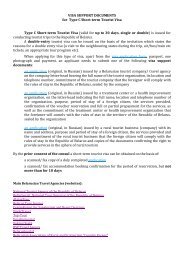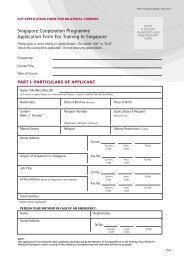table 1 <strong>Human</strong> <strong>Development</strong> index and its components<strong>Human</strong> <strong>Development</strong>Index (HDI)Life expectancyat birthMean years ofschoolingExpected yearsof schoolingGross national income(GNI) per capitaGNI per capita rankminus HDI rankNonincomeHDIValue (years) (years) (years) (2005 PPP $) ValueHDI rank 2012 2012 2010 a 2011 b 2012 2012 2012124 Vanuatu 0.626 71.3 6.7 e 10.6 3,960 –1 0.672125 Kyrgyzstan 0.622 68.0 9.3 12.6 2,009 24 0.738125 Tajikistan 0.622 67.8 9.8 11.5 2,119 19 0.731127 Viet Nam 0.617 75.4 5.5 11.9 2,970 9 0.686128 Namibia 0.608 62.6 6.2 11.3 5,973 –27 0.611129 Nicaragua 0.599 74.3 5.8 10.8 2,551 10 0.671130 Morocco 0.591 72.4 4.4 10.4 4,384 –13 0.608131 Iraq 0.590 69.6 5.6 10.0 3,557 –4 0.623132 Cape Verde 0.586 74.3 3.5 e 12.7 3,609 –6 0.617133 Guatemala 0.581 71.4 4.1 10.7 4,235 –14 0.596134 Timor-Leste 0.576 62.9 4.4 s 11.7 5,446 –29 0.569135 Ghana 0.558 64.6 7.0 11.4 1,684 22 0.646136 Equatorial Guinea 0.554 51.4 5.4 o 7.9 21,715 –97 0.463136 India 0.554 65.8 4.4 10.7 3,285 –3 0.575138 Cambodia 0.543 63.6 5.8 10.5 2,095 9 0.597138 Lao People’s Democratic Republic 0.543 67.8 4.6 10.1 2,435 2 0.584140 Bhutan 0.538 67.6 2.3 s 12.4 5,246 –31 0.516141 Swaziland 0.536 48.9 7.1 10.7 5,104 –30 0.515Low human development142 Congo 0.534 57.8 5.9 10.1 2,934 –5 0.553143 Solomon Islands 0.530 68.2 4.5 p 9.3 2,172 1 0.572144 Sao Tome and Principe 0.525 64.9 4.7 s 10.8 1,864 7 0.579145 Kenya 0.519 57.7 7.0 11.1 1,541 15 0.588146 Bangladesh 0.515 69.2 4.8 8.1 1,785 9 0.567146 Pakistan 0.515 65.7 4.9 7.3 2,566 –9 0.534148 Angola 0.508 51.5 4.7 s 10.2 4,812 –35 0.479149 Myanmar 0.498 65.7 3.9 9.4 1,817 5 0.537150 Cameroon 0.495 52.1 5.9 10.9 2,114 –4 0.520151 Madagascar 0.483 66.9 5.2 p 10.4 828 28 0.601152 Tanzania, United Republic of 0.476 58.9 5.1 9.1 1,383 10 0.527153 Nigeria 0.471 52.3 5.2 s 9.0 2,102 –6 0.482154 Senegal 0.470 59.6 4.5 8.2 1,653 4 0.501155 Mauritania 0.467 58.9 3.7 8.1 2,174 –12 0.473156 Papua New Guinea 0.466 63.1 3.9 5.8 e 2,386 –15 0.464157 Nepal 0.463 69.1 3.2 8.9 1,137 11 0.526158 Lesotho 0.461 48.7 5.9 c 9.6 1,879 –8 0.476159 Togo 0.459 57.5 5.3 10.6 928 16 0.542160 Yemen 0.458 65.9 2.5 8.7 1,820 –7 0.474161 Haiti 0.456 62.4 4.9 7.6 e 1,070 7 0.521161 Uganda 0.456 54.5 4.7 11.1 1,168 5 0.511163 Zambia 0.448 49.4 6.7 8.5 1,358 0 0.483164 Djibouti 0.445 58.3 3.8 o 5.7 2,350 –22 0.435165 Gambia 0.439 58.8 2.8 8.7 1,731 –9 0.448166 Benin 0.436 56.5 3.2 9.4 1,439 –5 0.459167 Rwanda 0.434 55.7 3.3 10.9 1,147 0 0.476168 Côte d’Ivoire 0.432 56.0 4.2 6.5 1,593 –9 0.444169 Comoros 0.429 61.5 2.8 p 10.2 986 4 0.484170 Malawi 0.418 54.8 4.2 10.4 774 10 0.492171 Sudan 0.414 61.8 3.1 4.5 1,848 –19 0.405172 Zimbabwe 0.397 52.7 7.2 10.1 424 t 14 0.542173 Ethiopia 0.396 59.7 2.2 s 8.7 1,017 –2 0.425174 Liberia 0.388 57.3 3.9 10.5 e 480 11 0.502175 Afghanistan 0.374 49.1 3.1 8.1 1,000 –3 0.393176 Guinea-Bissau 0.364 48.6 2.3 o 9.5 1,042 –6 0.373177 Sierra Leone 0.359 48.1 3.3 7.3 e 881 0 0.380178 Burundi 0.355 50.9 2.7 11.3 544 4 0.423178 Guinea 0.355 54.5 1.6 s 8.8 941 –4 0.368180 Central African Republic 0.352 49.1 3.5 6.8 722 1 0.386181 Eritrea 0.351 62.0 3.4 e 4.6 531 3 0.418182 Mali 0.344 51.9 2.0 c 7.5 853 –4 0.359183 Burkina Faso 0.343 55.9 1.3 o 6.9 1,202 –18 0.332184 Chad 0.340 49.9 1.5 p 7.4 1,258 –20 0.324185 Mozambique 0.327 50.7 1.2 9.2 906 –9 0.327146 | <strong>Human</strong> <strong>Development</strong> <strong>Report</strong> <strong>2013</strong>
<strong>Human</strong> <strong>Development</strong> <strong>Report</strong> <strong>2013</strong>The Rise of the South <strong>Human</strong> Progress in a Diverse World<strong>Human</strong> <strong>Development</strong>Index (HDI)Life expectancyat birthMean years ofschoolingExpected yearsof schoolingGross national income(GNI) per capitaGNI per capita rankminus HDI rankNonincomeHDIValue (years) (years) (years) (2005 PPP $) ValueHDI rank 2012 2012 2010 a 2011 b 2012 2012 2012186 Congo, Democratic Republic of the 0.304 48.7 3.5 8.5 319 0 0.404186 Niger 0.304 55.1 1.4 4.9 701 –4 0.313Other countries or territoriesKorea, Democratic People’s Rep. of .. 69.0 .. .. .. .. ..Marshall Islands .. 72.3 .. 11.7 .. .. ..Monaco .. 82.3 .. .. .. .. ..Nauru .. 80.0 .. 9.3 .. .. ..San Marino .. 81.9 .. 12.5 .. .. ..Somalia .. 51.5 .. 2.4 .. .. ..South Sudan .. .. .. .. .. .. ..Tuvalu .. 67.5 .. 10.8 .. .. ..<strong>Human</strong> <strong>Development</strong> Index groupsVery high human development 0.905 80.1 11.5 16.3 33,391 — 0.927High human development 0.758 73.4 8.8 13.9 11,501 — 0.781Medium human development 0.640 69.9 6.3 11.4 5,428 — 0.661Low human development 0.466 59.1 4.2 8.5 1,633 — 0.487RegionsArab States 0.652 71.0 6.0 10.6 8,317 — 0.658East Asia and the Pacific 0.683 72.7 7.2 11.8 6,874 — 0.712Europe and Central Asia 0.771 71.5 10.4 13.7 12,243 — 0.801Latin America and the Caribbean 0.741 74.7 7.8 13.7 10,300 — 0.770South Asia 0.558 66.2 4.7 10.2 3,343 — 0.577Sub-Saharan Africa 0.475 54.9 4.7 9.3 2,010 — 0.479Least developed countries 0.449 59.5 3.7 8.5 1,385 — 0.475Small island developing states 0.648 69.8 7.3 10.7 5,397 — 0.673World 0.694 70.1 7.5 11.6 10,184 — 0.690Notesa Data refer to 2010 or the most recent year available.b Data refer to 2011 or the most recent year available.c Updated by HDRO based on UNESCO Institute forStatistics (2012) data.d For the HDI calculation this value is capped at18 years.e Based on cross-country regression.f Calculated by the Singapore Ministry of Education.g Assumes the same adult mean years of schoolingas Switzerland before the most recent update.h Estimated using the purchasing power parity(PPP) rate and the projected growth rate ofSwitzerland.i Assumes the same adult mean years of schoolingas Spain before the most recent update.j Estimated using the PPP rate and the projectedgrowth rate of Spain.k Based on implied PPP conversion factors fromIMF (2012).l Based on the UNESCO Institute for Statistics(2012) estimate of educational attainmentdistribution.m Based on projected growth rates by ADB (2012).n PPP estimate based on cross-country regression;projected growth rate based on ECLAC (2012) andUNDESA (2012c) projected growth rates.o Based on data from UNICEF Multiple IndicatorCluster Surveys for 2002–2012.p Based on data on years of schooling of adultsfrom household surveys in the World Bank’sInternational Income Distribution Database.q Based on an unpublished estimate of the PPPconversion rate from the World Bank andprojected growth rates from UNESCWA (2012)and UNDESA (2012c).r Based on projected growth rates from UNDESA(2012c).s Based on data from ICF Macro (2012).t Based on PPP data from IMF (2012).DEFINITIONS<strong>Human</strong> <strong>Development</strong> Index (HDI): A compositeindex measuring average achievement in three basicdimensions of human development—a long andhealthy life, knowledge and a decent standard ofliving. See Technical note 1 at http://hdr.undp.org/en/media/HDR_<strong>2013</strong>_EN_TechNotes.pdf for detailson how the HDI is calculated.Life expectancy at birth: Number of years anewborn infant could expect to live if prevailingpatterns of age-specific mortality rates at the time ofbirth stay the same throughout the infant’s life.Mean years of schooling: Average number ofyears of education received by people ages 25 andolder, converted from educational attainment levelsusing official durations of each level.Expected years of schooling: Number of yearsof schooling that a child of school entrance agecan expect to receive if prevailing patterns ofage-specific enrolment rates persist throughout thechild’s life.Gross national income (GNI) per capita:Aggregate income of an economy generated byits production and its ownership of factors ofproduction, less the incomes paid for the use offactors of production owned by the rest of the world,converted to international dollars using PPP rates,divided by midyear population.GNI per capita rank minus HDI rank: Differencein rankings by GNI per capita and by the HDI. Anegative value means that the country is betterranked by GNI than by the HDI.Nonincome HDI: Value of the HDI computed fromthe life expectancy and education indicators only.MAIN DATA SOURCESColumn 1: HDRO calculations based on data fromUNDESA (2011), Barro and Lee (2011), UNESCOInstitute for Statistics (2012), World Bank (2012a)and IMF (2012).Column 2: UNDESA (2011).Column 3: Barro and Lee (2011) and HDRO updatesbased on data on educational attainment fromUNESCO Institute for Statistics (2012) and onmethodology from Barro and Lee (2010).Column 4: UNESCO Institute for Statistics (2012).Column 5: HDRO calculations based on data fromWorld Bank (2012a), IMF (2012) and UNSD (2012a).Column 6: Calculated based on data in columns1 and 5.Column 7: Calculated based on data in columns2, 3 and 4.Table 1 <strong>Human</strong> <strong>Development</strong> Index and its components | 147
- Page 1 and 2:
WNSEHuman DevelopmentReport 2013The
- Page 3 and 4:
Human Development Report 2013The Ri
- Page 5 and 6:
Human Development Report 2013 TeamD
- Page 7 and 8:
Finally, the Report also calls for
- Page 9 and 10:
Heather Simpson, Ben Slay, Mounir T
- Page 11 and 12:
3.6 India’s Supreme Court issues
- Page 13 and 14:
OverviewOne of the most heartening
- Page 15 and 16:
and sustainability are fully incorp
- Page 17 and 18:
Without investment in people, retur
- Page 19 and 20:
opportunity to reap the full benefi
- Page 21 and 22:
Woods institutions, the United Nati
- Page 23 and 24:
IntroductionWhen developed economie
- Page 25 and 26:
leading economies—Brazil, China a
- Page 27 and 28:
comparable access to information, e
- Page 29 and 30:
mobile phones: cellular banking is
- Page 32 and 33:
“The political problem ofmankind
- Page 34 and 35:
BOX 1.1Fairness, macroeconomics and
- Page 36 and 37:
BOX 1.3Amartya Sen, Nobel Laureate
- Page 38 and 39:
FIGURE 1.1Income per capita is risi
- Page 40 and 41:
BOX 1.4Subjective indicators of wel
- Page 42 and 43:
FIGURE 1.4There is notable variatio
- Page 44 and 45:
FIGURE 1.6Most regions show declini
- Page 46 and 47:
Progress in humandevelopment achiev
- Page 48 and 49:
BOX 1.7Social competencies: human d
- Page 50 and 51:
TABLE 1.3Inequality and satisfactio
- Page 52 and 53:
Not all countries havethe precondit
- Page 54 and 55:
“When the music changes,so does t
- Page 56 and 57:
BOX 2.1The South’s integration wi
- Page 58 and 59:
FIGURE 2.1As a share of world merch
- Page 60 and 61:
BOX 2.2Acquisitions by the South of
- Page 62 and 63:
FIGURE 2.3Between 2000 and 2010, In
- Page 64 and 65:
FIGURE 2.4Export earnings per capit
- Page 66 and 67:
BOX 2.6Final assembly is about more
- Page 68 and 69:
Instead of having a centreof indust
- Page 70 and 71:
FIGURE 2.6Emerging market economies
- Page 72 and 73:
Developing countriestrade more amon
- Page 74 and 75:
“We cannot expect thatall nations
- Page 76 and 77:
TABLE 3.1Selected developing countr
- Page 78 and 79:
A common featureof countries thatha
- Page 80 and 81:
More important thangetting prices r
- Page 82 and 83:
BOX 3.5Eastern Europe and Central A
- Page 84 and 85:
States have to beconscious that the
- Page 86 and 87:
As countries develop,they tend to d
- Page 88 and 89:
Having weathered theAsian financial
- Page 90 and 91:
Providing publicservices that contr
- Page 92 and 93:
Advancing health requiresmore than
- Page 94 and 95:
Universal public healthand educatio
- Page 96 and 97:
• China. The Minimum Livelihood G
- Page 98 and 99:
“Each generation will reap whatth
- Page 100 and 101:
concerns will make for a complex en
- Page 102 and 103:
A greater emphasison education cans
- Page 104 and 105:
FIGURE 4.1Under the fast track scen
- Page 106 and 107:
Around the worldpeople are calling
- Page 108 and 109: FIGURE 4.4Different environmental s
- Page 110 and 111: FIGURE 4.5Education policies can al
- Page 112 and 113: BOX 4.2China and Ghana: who benefit
- Page 114 and 115: FIGURE 4.8countries thus converge t
- Page 116 and 117: “Let us join hands to try tocreat
- Page 118 and 119: Areas of globalinternational concer
- Page 120 and 121: Addressing climatechange requires t
- Page 122 and 123: International governanceis increasi
- Page 124 and 125: BOX 5.2Jo Leinen, Member of the Eur
- Page 126 and 127: facilitates reserve investments and
- Page 128 and 129: Responsible sovereigntytakes the lo
- Page 130 and 131: FIGURE 5.1Under the accelerated pro
- Page 132 and 133: Good policymakingrequires greater f
- Page 134 and 135: A fair and less unequalworld requir
- Page 137 and 138: NotesOverview1 Atsmon and others 20
- Page 139 and 140: 25 Blinder 2006.26 UNIDO 2009.27 UN
- Page 141 and 142: which is 61.7 deaths per 1,000 live
- Page 143 and 144: ReferencesAbdurazakov, A., A. Minsa
- Page 145 and 146: urban_world_cities_and_the_rise_of_
- Page 147 and 148: Kamau, P., D. McCormick, and N. Pin
- Page 149 and 150: Labor Administration. Geneva: Inter
- Page 151 and 152: Human Development Report 2013The Ri
- Page 153 and 154: Statistical acknowledgementsThe Rep
- Page 155 and 156: Key to HDI countries and ranks, 201
- Page 157: Human Development Report 2013The Ri
- Page 161 and 162: Human Development Report 2013The Ri
- Page 163 and 164: Human Development Report 2013The Ri
- Page 165 and 166: Human Development Report 2013The Ri
- Page 167 and 168: Human Development Report 2013The Ri
- Page 169 and 170: Human Development Report 2013The Ri
- Page 171 and 172: Human Development Report 2013The Ri
- Page 173 and 174: Human Development Report 2013The Ri
- Page 175 and 176: Human Development Report 2013The Ri
- Page 177 and 178: Human Development Report 2013The Ri
- Page 179 and 180: Human Development Report 2013The Ri
- Page 181 and 182: Human Development Report 2013The Ri
- Page 183 and 184: Human Development Report 2013The Ri
- Page 185 and 186: Human Development Report 2013The Ri
- Page 187 and 188: Human Development Report 2013The Ri
- Page 189 and 190: Human Development Report 2013The Ri
- Page 191 and 192: Human Development Report 2013The Ri
- Page 193 and 194: Human Development Report 2013The Ri
- Page 195 and 196: Human Development Report 2013The Ri
- Page 197 and 198: Human Development Report 2013The Ri
- Page 199 and 200: Human Development Report 2013The Ri
- Page 201 and 202: Human Development Report 2013The Ri
- Page 203 and 204: Human Development Report 2013The Ri
- Page 205 and 206: Human Development Report 2013The Ri
- Page 207 and 208: Human Development Report 2013The Ri
- Page 209 and 210:
Human Development Report 2013The Ri
- Page 211 and 212:
Statistical referencesADB (Asian De
- Page 213 and 214:
Core features of the model pertinen
- Page 215 and 216:
Countries and HDI ranks in 2012 and
















